racism
Million Hoodie March
Dark Girls
One of the most moving videos I’ve seen in a while, Dark Girls: Preview is from an upcoming documentary exploring deep-seated attitudes about skin color and women in the U.S.
Native Signs

Signs in Bemidji, Minnesota used to read “No Indians Allowed.” Now local businesses increasingly announce their facilities in both English and Ojibwe.
Racism and social exclusion have a long history in the town, but as Tanya Lee writes, a 2005 proposal to voluntarily incorporate Ojibwe words on public signage is having a growing impact:
The idea came in part from Hawaii, where [Michael] Meuers had lived for a year in the 1960s. On the islands, he recalled, native language and culture are a part of everyday life for everyone, as the familiarity with words such as mahalo, luau, aloha, lei and hula prove. On restroom doors, the words men and women are displayed in English and in Hawaiian.
In 2005, a student at Red Lake High School, a school for Red Lake students run by the state of Minnesota, opened fire on the campus with a shotgun and a semiautomatic pistol, killing seven.
“The next day, I was talking to the city manager and noticed a Red Lake flag on a shelf,” Meuers said. “I was working for the tribe at that point and I suggested the city fly the flag. The Red Lake flag flew at half-staff outside City Hall for a week. I never heard so many positive comments about Bemidji. It was the people of the city saying, ‘Bemidji is crying for the Red Lake babies too.’ ”
This prompted Meuers to take his simple idea about the bathroom signs to Shared Visions, a community organization dedicated to addressing the issues of racial disparity and bias. Rachelle Houle served with Meuers on the Cultural Understanding and Respect Committee, and together they set the goal of placing restroom signs in both Ojibwe and English in 20 businesses within a year. Meuers volunteered to pay for the signs.…
“Michael and I both feel a change happening here,” Houle said. “For so long, the Ojibwe culture and people have not been respected here. This is a way of saying, ‘You are valuable.’ It’s a way of showing respect and making people welcome in Bemidji.”…
[Dr. Anton Treuer, professor of Ojibwe at Bemidji State University] says the university has received many calls and e-mails about how to replicate the [universty’s signage] program, and he believes it can serve as a template for other tribes. “We were taking our signs around town when we started,” Meuers said, “and now people are coming to us, not only from the U.S. but also from Canada.”
Tiny Nationalisms
 Eleanor Roosevelt famously wrote, “Where, after all, do universal human rights begin? In small places, close to home.“ By implication, the same could be said for racism, nationalism and other ideologies.
Eleanor Roosevelt famously wrote, “Where, after all, do universal human rights begin? In small places, close to home.“ By implication, the same could be said for racism, nationalism and other ideologies.
Official Representations of the Nation: Comparing the Postage Stamps of Sudan and Burkina Faso looks at the ideology of stamps:
“Sudan’s stamps focus on the political center and dominant elite (current regime, Khartoum politicians, and Arab and Islamic identity) while Burkina Faso’s stamps focus on society (artists, multiple ethnic groups, and development). Sudan’s stamps build an image of the nation as being about the northern-dominated regime in Khartoum (whether military or parliamentary); Burkina Faso’s stamps project an image of the nation as multi-ethnic and development-oriented.”
Ethnic identity is, of course, a tool in the Sudan government’s repression of Darfur.
Worn on its Sleeve
The chattering classes are aflutter that the President of Iran yesterday called Israel “a cruel and repressive racist regime” at the UN Conference on Racism. 23 diplomats stormed out, others applauded. While Ahmadinejad has said some pretty outrageous things, in this case I wonder if he saw this latest item in the Israeli daily Haaretz about T-shirt designs Israeli soldiers are ordering for their IDF units. The shirts boast slogans and images of dead Palestinian babies, bombed mosques, jokes about rape, sniping children, killing pregnant women in Hijab, etc. The designs are revealing. This is clearly not a military culture solely preoccupied with defending the integrity of the State.
A Place to Live, Breathe, and Work
The Center for the Study of Political Graphics has posted three new online exhibitions of posters from their archives. The collections are organized thematically, around a dozen posters per theme, spanning several decades, countries, and struggles.
Notice the tiny “next” links at the bottom of some of the pages. They’re very easy to miss.
Earth, Wind & Solar
International Ecology Posters
From the site:
 “Global Warming. Arsenic in drinking water. Pesticide Poisoning. Environmental Racism. Nuclear Waste Disposal. Irradiated and Genetically Modified Food. The list is endless. Where pollution is concerned, the world is a global village where no continent, country, or neighborhood is safe. Multinational corporations’ insatiable need for new markets and greater profits consistently overrides environmental concerns, and few governments oppose them. But these posters convey an increasing sense of urgency, as international artists continue to use the power of graphics to organize a frontline of defense against rapidly escalating pollution.”
“Global Warming. Arsenic in drinking water. Pesticide Poisoning. Environmental Racism. Nuclear Waste Disposal. Irradiated and Genetically Modified Food. The list is endless. Where pollution is concerned, the world is a global village where no continent, country, or neighborhood is safe. Multinational corporations’ insatiable need for new markets and greater profits consistently overrides environmental concerns, and few governments oppose them. But these posters convey an increasing sense of urgency, as international artists continue to use the power of graphics to organize a frontline of defense against rapidly escalating pollution.”
The posters are organized as follows:
- Early Environmental Awareness
- Global Warming
- Water Pollution
- Air Pollution
- Deforestation
- Pesticides And G.M.O.s
- Nuclear Power And Waste
- Environmental Disasters
- Environmental Racism
- Martyrs
- Green Alternatives
- Visions For The Future
We Shall Not Be Moved
International Graphics on Gentrification and Homelessness
From the site:
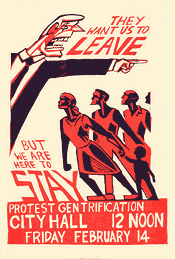 “A missed paycheck, a health crisis, or an unpaid bill are all that separate many people from homelessness. As America’s income gap widens, renters worry if they can ever buy homes of their own—or keep their rentals through retirement. The lack of affordable housing is not just a U.S. problem. We Shall Not Be Moved uses domestic and international posters to show that homelessness and gentrification are major issues throughout the world—and from the U.S. to Europe to Australia, posters remain the resisters’ tools of choice. Posters announce demonstrations to oppose demolitions, support squatters’ rights to move into abandoned buildings, and organize tenants’ unions. They document victories, defeats, and ongoing confrontations. Posters both record these struggles, and are central to them. They show that victory does not happen overnight—it can take years—but it is possible to fight city hall and the developers and win.”
“A missed paycheck, a health crisis, or an unpaid bill are all that separate many people from homelessness. As America’s income gap widens, renters worry if they can ever buy homes of their own—or keep their rentals through retirement. The lack of affordable housing is not just a U.S. problem. We Shall Not Be Moved uses domestic and international posters to show that homelessness and gentrification are major issues throughout the world—and from the U.S. to Europe to Australia, posters remain the resisters’ tools of choice. Posters announce demonstrations to oppose demolitions, support squatters’ rights to move into abandoned buildings, and organize tenants’ unions. They document victories, defeats, and ongoing confrontations. Posters both record these struggles, and are central to them. They show that victory does not happen overnight—it can take years—but it is possible to fight city hall and the developers and win.”
The posters are organized as follows:
- Introduction
- Development & Speculation
- Homelessness & Poverty
- Organizing Resistance
- War & Displacement
- Conclusion
Solidarity Forever!
Graphics of the International Labor Movement
From the site:
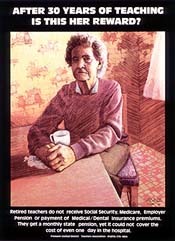 “Organized labor has consistently produced more political graphics than any other domestic movement for social change. Labor posters are often produced in the midst of a strike or boycott and convey the urgency of the times. Others are commemoratives, marking the anniversary of a victory or a martyred labor leader. They remind viewers of a too often hidden history, rally against dangerous conditions in the workplace, and warn that such injustices still occur. Although many of the posters are historical, the issues are not. The eight-hour day is no longer sacrosanct. More and more children are entering the workforce. Pesticides threaten farm workers and consumers. Sweatshops are proliferating domestically and internationally. These graphic expressions of international solidarity are a powerful combination of art and politics, crossing borders of time and place.”
“Organized labor has consistently produced more political graphics than any other domestic movement for social change. Labor posters are often produced in the midst of a strike or boycott and convey the urgency of the times. Others are commemoratives, marking the anniversary of a victory or a martyred labor leader. They remind viewers of a too often hidden history, rally against dangerous conditions in the workplace, and warn that such injustices still occur. Although many of the posters are historical, the issues are not. The eight-hour day is no longer sacrosanct. More and more children are entering the workforce. Pesticides threaten farm workers and consumers. Sweatshops are proliferating domestically and internationally. These graphic expressions of international solidarity are a powerful combination of art and politics, crossing borders of time and place.”
The posters are organized as follows:
Orientation
From Beyond Vietnam: A Time to Break Silence:
“In 1957 a sensitive American official overseas said that it seemed to him that our nation was on the wrong side of a world revolution. During the past ten years we have seen emerge a pattern of suppression which now has justified the presence of U.S. military ‘advisors’ in Venezuela. This need to maintain social stability for our investments accounts for the counter-revolutionary action of American forces in Guatemala. It tells why American helicopters are being used against guerrillas in Colombia and why American napalm and green beret forces have already been active against rebels in Peru. It is with such activity in mind that the words of the late John F. Kennedy come back to haunt us. Five years ago he said, ‘Those who make peaceful revolution impossible will make violent revolution inevitable.’
Increasingly, by choice or by accident, this is the role our nation has taken — the role of those who make peaceful revolution impossible by refusing to give up the privileges and the pleasures that come from the immense profits of overseas investment.
I am convinced that if we are to get on the right side of the world revolution, we as a nation must undergo a radical revolution of values. We must rapidly begin the shift from a ‘thing-oriented’ society to a ‘person-oriented’ society. When machines and computers, profit motives and property rights are considered more important than people, the giant triplets of racism, materialism, and militarism are incapable of being conquered.
A true revolution of values will soon cause us to question the fairness and justice of many of our past and present policies. On the one hand we are called to play the good Samaritan on life’s roadside; but that will be only an initial act. One day we must come to see that the whole Jericho road must be transformed so that men and women will not be constantly beaten and robbed as they make their journey on life’s highway. True compassion is more than flinging a coin to a beggar; it is not haphazard and superficial. It comes to see that an edifice which produces beggars needs restructuring. A true revolution of values will soon look uneasily on the glaring contrast of poverty and wealth. With righteous indignation, it will look across the seas and see individual capitalists of the West investing huge sums of money in Asia, Africa and South America, only to take the profits out with no concern for the social betterment of the countries, and say: ‘This is not just.’ It will look at our alliance with the landed gentry of Latin America and say: ‘This is not just.’ The Western arrogance of feeling that it has everything to teach others and nothing to learn from them is not just. A true revolution of values will lay hands on the world order and say of war: ‘This way of settling differences is not just.’ This business of burning human beings with napalm, of filling our nation’s homes with orphans and widows, of injecting poisonous drugs of hate into veins of people normally humane, of sending men home from dark and bloody battlefields physically handicapped and psychologically deranged, cannot be reconciled with wisdom, justice and love. A nation that continues year after year to spend more money on military defense than on programs of social uplift is approaching spiritual death.
This kind of positive revolution of values is our best defense against communism. War is not the answer. Communism will never be defeated by the use of atomic bombs or nuclear weapons. Let us not join those who shout war and through their misguided passions urge the United States to relinquish its participation in the United Nations. These are days which demand wise restraint and calm reasonableness. We must not call everyone a Communist or an appeaser who advocates the seating of Red China in the United Nations and who recognizes that hate and hysteria are not the final answers to the problem of these turbulent days. We must not engage in a negative anti-communism, but rather in a positive thrust for democracy, realizing that our greatest defense against communism is to take offensive action in behalf of justice. We must with positive action seek to remove those conditions of poverty, insecurity and injustice which are the fertile soil in which the seed of communism grows and develops.”
— Dr. Martin Luther King, Jr., April 4, 1967.
Search and replace “napalm” with “depleted uranium”, “Communism” with “terrorism”, “the seating of Red China in the United Nations” with “withdrawing from Iraq.”
Fed Up with The Front
Since 1991, Ras l’front (“Fed up with the Front”) has campaigned against Jean-Marie Le Pen and his extreme right-wing party, the National Front. Ras l’Front collectives are active in cities throughout France.
See this collection of their posters on racism, fascism, sexism, immigrant rights, and other issues.
Green, Low-Income Housing in Santa Monica
Colorado Court is a 5-story, 44 unit single room occupancy apartment complex for low income tenants in Santa Monica. It is also one of the first buildings of its kind in the United States that is 100% energy independent, generating nearly all its own energy for electricity, heat and light.
Architectural Review, November 1, 2002:
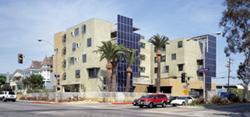 “In both siting and form, the building has been designed to exploit passive environmental control strategies such as natural ventilation, maximizing daylight and shading south-facing windows. But it also incorporates a number of innovative energy generation measures, notably a natural gas-powered turbinecum-heat recovery system that generates the base electrical load and services the building’s hot water needs. Photovoltaic panels set in the walls and roof supply most of the peak-load energy demand. This co-generation system converts natural gas into electricity to meet the building’s power needs. The same system also captures and uses waste heat to produce hot water and space heating for residents throughout the year. Unused energy from the photovoltaic panels is returned to the grid during the day and retrieved at night as needed. The architects estimate that these energy generation and conservation systems will pay for themselves in less than 10 years and annual savings in electricity and natural gas bills should average around $6000....
“In both siting and form, the building has been designed to exploit passive environmental control strategies such as natural ventilation, maximizing daylight and shading south-facing windows. But it also incorporates a number of innovative energy generation measures, notably a natural gas-powered turbinecum-heat recovery system that generates the base electrical load and services the building’s hot water needs. Photovoltaic panels set in the walls and roof supply most of the peak-load energy demand. This co-generation system converts natural gas into electricity to meet the building’s power needs. The same system also captures and uses waste heat to produce hot water and space heating for residents throughout the year. Unused energy from the photovoltaic panels is returned to the grid during the day and retrieved at night as needed. The architects estimate that these energy generation and conservation systems will pay for themselves in less than 10 years and annual savings in electricity and natural gas bills should average around $6000....
Details such as fluorescent lights which automatically extinguish when a room is not in use, insulation made from recycled newspapers, a bike store, CFC-free refrigerators and a trash recycling room reinforce the evangelical message. As many of the technologies are relatively unproven, it is hoped that in its intelligent exploration of the potential of sustainability, the building will act as a successful demonstration project for developers, planners, politicians, architects and, most especially, the wider public.”
The apartments themselves are 375 square feet studios with a kitchenette and a small bathroom. Shared areas include a lounge, laundry, and courtyard.
The project falls under Santa Monica’s “Sustainable City Program” which tries to reduce electricity and water consumption, and install photovoltaic cells on in public and private projects.
Los Angeles Times, June 26, 2001:
“A host of public and private entities—including the cities of Santa Monica and Irvine, Southern California Edison and the California Energy Coalition—are involved in planning, funding and monitoring the innovative building. The two cities, the conservation group and the utility have formed a group known as Regional Energy Efficiency Initiative, which has contributed about $250,000 to energy-saving devices in the building. In addition, Santa Monica itself is contributing about $250,000 toward electricity generators.
The building will be loaded with energy-saving and environmentally benign or ‘sustainable’ devices. Heat from the micro-turbine will produce hot water, eliminating the need for a conventional water heater....
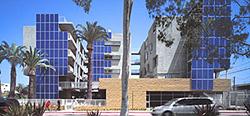 Prevailing breezes will cool the building, which will have no mechanical air conditioners. The U-shaped structure ‘acts like a giant wind scoop,’ said architect Larry Scarpa, a principal of Santa Monica-based Pugh & Scarpa.
Prevailing breezes will cool the building, which will have no mechanical air conditioners. The U-shaped structure ‘acts like a giant wind scoop,’ said architect Larry Scarpa, a principal of Santa Monica-based Pugh & Scarpa.
In yet another ‘green’ flourish, the building will collect all the rainwater from the alley behind the property and funnel it into a series of underground chambers. The water will slowly percolate back into the soil, which will filter the pollutants from the water while preventing contaminated water from spilling into Santa Monica Bay. The drainage system was paid for separately by the city of Santa Monica.
The concept of a building that would be energy self-sufficient emerged about two years ago, when Santa Monica officials met with members of the California Energy Coalition. The city’s Housing Division, which funds construction of low-income housing, chose to make a low-income housing project into a dream project of ‘green’ construction, and Colorado Court became the target.
‘We needed a demonstration project because a lot of developers feel that the technologies are unproven,’ Raida said.
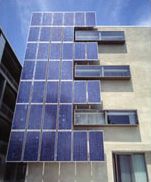 A number of apartment buildings in Santa Monica and Irvine are to be equipped with energy-saving technology by the Regional Energy Efficiency Initiative, but the Santa Monica building is the only project attempting to provide its own power as well.
A number of apartment buildings in Santa Monica and Irvine are to be equipped with energy-saving technology by the Regional Energy Efficiency Initiative, but the Santa Monica building is the only project attempting to provide its own power as well.
Rebates from the state Energy Commission helped defray the high cost of the energy-generating equipment. The state’s rebate on the solar panels, which cost about $225,000, will be about $62,000. The $57,000 micro-turbine and heat exchanger will yield a $15,000 rebate from Southern California Gas Co.
If recent research and development has yielded new ways of conserving energy and producing electricity, regulations and building codes have not kept pace.
In one instance, architects had to obtain special permission from the city to hang solar panels outside the exterior stairwells because building inspectors said the solar panels ‘enclosed’ the stairwells and triggered requirements for floors, ceilings and fire-rated walls.”
Santa Monica Mirror, December 6-12, 2000:
“[Architects] Pugh Scarpa Kodama and the Community Corporation have been working with the City of Santa Monica and Southern California Edison to come up with an ‘incentive-type’ plan, which would allot a certain amount of energy to each resident per month, and would award those who did not use the full amount with rebates on their energy bills....
Colorado Court’s units will rent for between $316 and $365. They will be available to low-income residents culled from the Community Corp’s waiting list, who meet the low-income requirements for this building. Twenty-two units will be rented to people making less than $12,775 yearly, another 22 to those making less than $14,600 yearly (these figures are based on 35 - 40% of the current median income of $36,500). According to Raida, the typical demographic for a building such as Colorado Court would include full time workers earning minimum wage, and people on fixed incomes such as retirees and the disabled.
The Community Corp’s waiting list currently numbers over 1,000 people.”
It’s great that the org’s and the city could pull together $5.8 million to build high-tech, green, low-income housing. But, experimenting on the poor for their demonstration project? Is this the flip side of environmental racism? Get some low-income tenants to live inside your the unproven technology? No air conditioning in Southern California? An experimental powerplant in the basement, and less-than-fire-rated exterior walls... that cover a fire exit? Evangelical indeed.
U.S. Racism in Pictures

“A documentary with 3,000 pictures, music, interviews and narration presented on two screens for audiences of up to 2,000... A lecture on racism, oppression, poverty and social injustice with more than 5,000 presentations in American and European Higher Education.”
...
See also 30 photos from 1937-1943 of signage enforcing racial discrimination. From the Library of Congress:
“Photographers working for the Farm Security Administration Historical Section (later transferred to the Office of War Information) were encouraged to document continuity and change in many aspects of life in America during the years the unit was in operation. They were particularly encouraged to photograph billboards and signs as one indicator of such developments. Although no documentation has been found to indicate that photographers were explicitly encouraged to photograph racial discrimination signs, the collection includes a significant number of this type of image, which is rarely found in other Prints and Photographs Division collections.”
page 2 1




